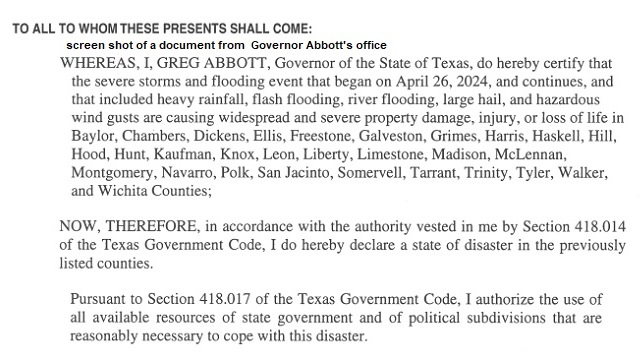
Several counties in the Brazos Valley are part of a disaster declaration issued by the governor following the latest round of severe weather.
Among the 29 counties are Grimes, Madison, Leon, Walker, and Montgomery counties.
The order gives state and local agencies the authority to use all available resources to deal with casualties and property damage resulting from storms that began last Friday (April 26) and continues to affect homes, businesses, and the agriculture industry.
Click HERE to read and download the governor’s disaster declaration.
News release from the governor’s office:
Governor Greg Abbott today issued a disaster declaration for 29 Texas counties impacted by severe storms and flooding that began last week and continues to affect homes, businesses, and the agricultural industry throughout the state. The counties in the Governor’s declaration include: Baylor, Chambers, Dickens, Ellis, Freestone, Galveston, Grimes, Harris, Haskell, Hill, Hood, Hunt, Kaufman, Knox, Leon, Liberty, Limestone, Madison, McLennan, Montgomery, Navarro, Polk, San Jacinto, Somervell, Tarrant, Trinity, Tyler, Walker, and Wichita counties.
“The State of Texas continues to provide support and assist communities who have been impacted by recent severe weather and flooding,” said Governor Abbott. “This disaster declaration will swiftly provide Texans with all readily available resources needed to recover following storms and flood activity. As several counties in East Texas continue to face ongoing weather threats, Texans in at-risk areas should remain aware of their flood risk and take necessary precautions to ensure the safety of themselves and their loved ones. I thank the countless emergency response personnel and first responders who are working around-the-clock to protect their fellow Texans.”
According to the National Weather Service, moderate-to-major river flooding is expected across the eastern half of the state beginning today and continuing over the next couple of weeks. Additionally, severe weather and excessive rainfall that could lead to flash flooding is expected across Texas through the weekend. Risks also include flooding, large hail, damaging winds, and possible tornadoes.
At the Governor’s direction, state agencies continue to support requests for state assistance. The following resources remain engaged and available to support local severe weather and flooding response operations:
• Texas A&M Engineering Extension Service (Texas A&M Task Force 1 and Texas Task Force 2): Urban Search & Rescue Teams; Swiftwater Boat Squads
• Texas National Guard: UH-60 Blackhawk helicopters with hoist capability; Ground Transportation Platoons with High Profile Vehicles
• Texas Division of Emergency Management: Emergency response personnel to support requests for state assistance from local officials
Additionally, the following state emergency response resources remain on standby to support local response operations:
• Texas A&M Forest Service: Incident Management Teams and saw crews
• Texas Department of State Health Services (Texas Emergency Medical Task Force): Wildland Fire Support Packages and Severe Weather Support Packages including paramedics and ambulances
• Texas Department of Transportation: Personnel and equipment to assist with road closures; motor graders to support emergency response operations
• Texas Department of Public Safety: Texas Highway Patrol Troopers to assist with road closures and traffic control; Tactical Marine Unit and helicopters with hoist capability
• Texas Parks and Wildlife Department: Park Law Enforcement and Game Wardens to provide law enforcement support; boat squads
• Texas A&M AgriLife Extension: Disaster Assessment and Recovery Agents as well as AgriLife Extension Agents to support agricultural and livestock needs
• Texas Animal Health Commission: Personnel to provide livestock support
• Texas Commission on Environmental Quality: Air/water/wastewater monitoring
• Public Utility Commission of Texas: Personnel to coordinate with utility providers across the threat area
• Railroad Commission of Texas: Monitoring of the state’s natural gas supply and communication with the oil and gas industry
• Texas Education Agency: Monitoring school district needs across the state
• Texas Department of Information Resources: Monitoring technology infrastructure
• Texas Voluntary Organizations Active in Disaster (Texas VOAD): Coordinating of volunteer organizations across the state
Local and state officials are currently assessing damage across the affected regions. As storm and flooding impacts continue across the state and severe weather remains in the forecast, officials will keep identifying damages and immediate resource needs. Officials will also make determinations about the state’s eligibility for various forms of federal disaster assistance for impacted residents. Additional counties may be added to the declaration at a later date.
To assist with the damage assessment process, Texans are urged to self-report damage to homes, businesses, and agriculture using the Individual State of Texas Assessment Tool (iSTAT), which can be accessed through damage.tdem.texas.gov. The information provided through iSTAT helps officials identify immediate resource needs and aids in determining eligibility for disaster assistance. The survey is available in English and Spanish and is accompanied by tutorial videos to aid in the submission process.
Amid the ongoing risk from storms and flooding, Texans are encouraged to monitor local forecasts, make an emergency plan, and follow directions from local officials. Texans can locate flood risk information at TexasFlood.org, check road conditions at DriveTexas.org, access safety information at TexasReady.gov, and visit tdem.texas.gov/prepare for preparedness tips.
